
Do you want to grow a Sansevieria Francisii Snake Plant but don’t know where to start? Or do you already have one but need some extra advice? Then this ultimate Sansevieria Francisii plant care guide is the perfect read for you. Read on to get all the tips and expert advice to grow a tall and healthy plant.
| Botanical Name (Latin Name/Scientific Name): | Sansevieria Francisii, Dracaena Francisii |
| Common Name: | Snake Plant, Sansevieria Francisii Chahin, Dracaena Francisii Chahin |
| Light: | Low light tolerant |
| Watering: | when the soil dries out to the bottom of the pot |
| Soil: | succulent or cactus mix |
| Repotting: | Once a year |
| Fertilizing: | once every 2-4 weeks with a succulent fertilizer |
| Temperature: | 18 to 24 C° (65 to 75 F°) |
| Humidity: | optimal 5% to 25%, but adapts well to any humidity level |
| Toxicity for Pets: | Toxic to cats and dogs (nausea, vomiting, diarrhea) |
| Toxicity for Humans: | Toxic (vomiting, diarrhea, dermatitis) |
| Propagation: |
|
| Pruning: | Prune dead or diseased growth or prune for propagation |
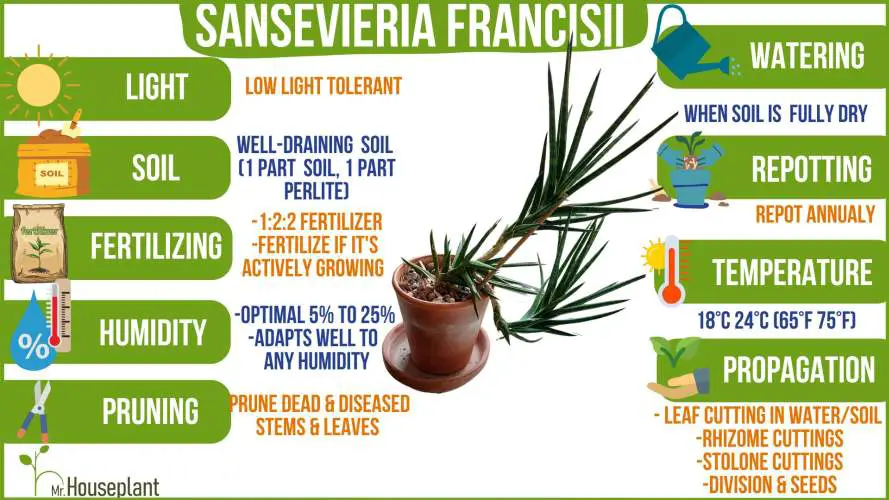
Light conditions, watering, repotting, soil, fertilizing, temperature, humidity, pruning and propagation requirements need to be followed in Sansevieria Francisii care routine to maintain a healthy and beautiful plant
Light Requirements
| Minimal amount of light: | 50 lux (5 FC) |
| Optimal amount of light: | 750+ lux (75+ FC) |
| Direct sun tolerance: | 5-6 hours |
| Category: | low-light tolerant |
Sansevieria Francisii prefers medium indirect light (light over 750 lux / 75 foot candles) and it can tolerate 5-6 hours of direct sunlight per day. If you can’t provide these light levels, Sansevieria Francisii Snake Plant can survive even in lower light, as low as 50 lux, but the new growth will be long and leggy. The more light you provide, the happier your plant will be. More light enhances photosynthesis and makes the plant more resistant to pests and diseases.
Can Sansevieria Francisii Tolerate Very Low Light?
Yes, Sansevieria Francisii can tolerate very low light, as low as 50 lux. It will live in light that is low, but it will not thrive. In low light new growth will be small and leggy and the leaves will be etiolated (stretched). Aim for medium indirect light for a healthy and good-looking Snake Plant (light over 750 lux).
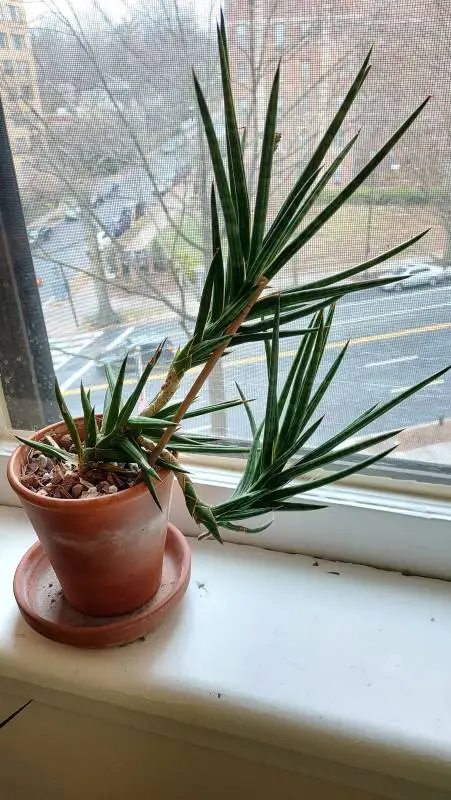
Dracaena Francisii aka Snake Plant is a drought-tolerant and handsome plant that can tolerate low light conditions
Water Needs
Water Sansevieria Francisii Chahin once the soil is fully dry, all the way to the bottom of the pot. To check the soil, stick a chopstick inside it, push it gently all the way down, and pull it out. If the chopstick comes out dry, with no soil attached to it, it’s time to water. If the chopstick comes out wet or dirty, with soil attached, this means the soil is still wet and you should hold off with watering. If you’re unsure, wait another week. With Snake plants, it’s always better to go on the side of underwatering. It is a drought-tolerant plant and can survive even a few months without water if needed.
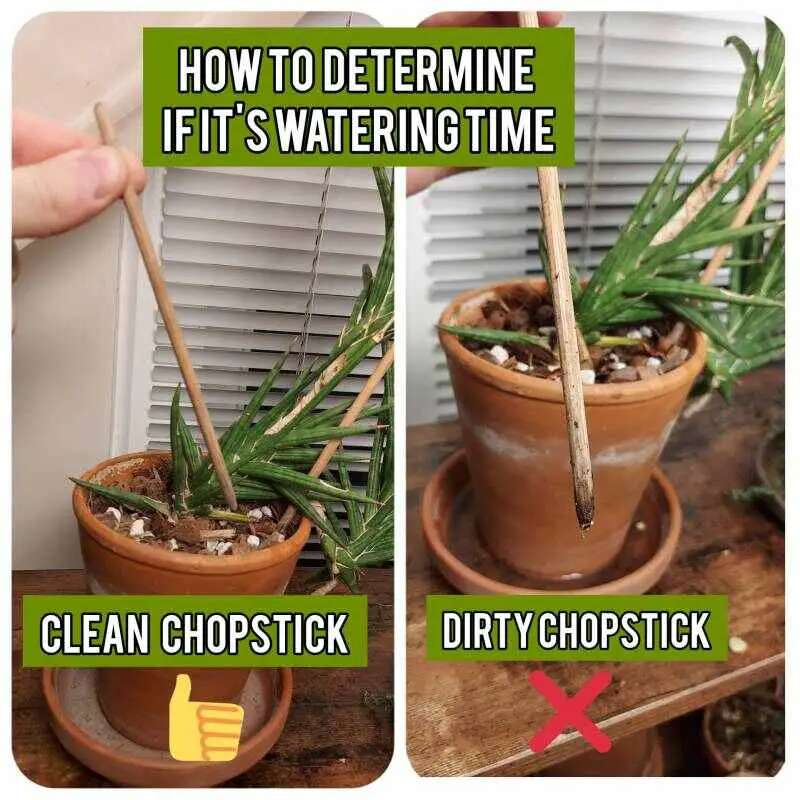
Water requirements for this Snake Plant are low. Use a chopstick to check if it’s watering time.
Humidity Needs
The optimal humidity for Sansevieria Francisii is between 5% and 25%. However, the plant adapts well to any humidity level. Even if the humidity in your home is over 70%, your plant will do just fine.
Temperature Requirements
The optimal temperature for Dracaena Francisii Snake Plant is between 18 to 24C° (65 to 75F°). Avoid temperature drops below 16C° (60F°). They will not harm the plant but will slow down root development and leaf development. The plant can also handle higher summer temps.
Fertilizing
Fertilize Sansevieria Francisii Snake Plants with a low-nitrogen succulent fertilizer once every 2 to 4 weeks. When fertilizing, make sure to follow the instructions on the fertilizer packaging and do not use more fertilizer than listed on the packaging.
An excellent succulent fertilizer is Espoma Succulent and Cacti Fertilizer. It is a low-nitrogen fertilizer with an N-P-K ratio of 1-2-2.
Please note that fertilizing these Snake Plants is not necessary if you repot the plant annually. By repotting annually, you will be providing fresh soil for the plant which contains a sufficient amount of nutrients.
Never fertilize a plant when it’s not growing. Since the plant won’t be able to use the nutrients, they will accumulate in the soil. And over time, they can burn the roots and damage the plant. So, it’s best to fertilize it during its growing season.
Soil
The best soil for Sansevieria Francisii is soil that dries out quickly between waterings. This soil type is called well-draining soil. You can make a potting mix consisting of 1 part of any store-bought potting mix and 1 part perlite, pumice, or coarse sand.
Store-bought potting mixes in most cases are not well-draining. They retain too much water. This means the soil dries out much slower which increases the chances of root rot. That’s why you need to amend them with perlite, pumice, or coarse sand to make them well-draining.
Another disadvantage of store-bought potting mixes is they mostly consist of peat moss or coco coir. Peat moss and coco coir consist of very tiny particles. These particles compact over time. When they get compacted, there isn’t much room for oxygen. And the lack of oxygen is the perfect environment for the development of bacteria or fungi that can cause root rot.
Repotting
To repot Sansevieria F. Chahin follow these steps:
- Take the plant out of its pot
- Lightly loosen the rootball
- Inspect the roots
- Cut off dead, soft, mushy roots if there are any
- Get one pot size larger pot
- Fill up 1/3 of the new pot with fresh soil (choose a pot with a drainage hole)
- Place the snake plant into the new pot
- Fill the pot with soil
- Press the soil lightly around the plant
- Water if the soil has been dry before repotting
Check out the video below to see how to repot this plant:
Toxicity To Pets
Snake plants contain saponin which is toxic to pets if ingested, according to the American Society For Prevention Of Cruelty To Animals (ASPCA). They aren’t lethal but can cause great discomfort to your furry friend. The usual symptoms are severe pain, vomiting, nausea, increased saliva, and diarrhea. So, unfortunately, the Dracaena Francisii plant isn’t a pet-friendly plant.
Toxicity To Humans
Sansevieria Francisii Snake Plants are toxic to humans when ingested and can cause minor illnesses such as vomiting or diarrhea, according to the University of California’s Division of Agriculture and Natural Resources. Snake plants can also cause dermatitis – skin rash or irritation.
If ingested, call the Poison Control Center or your doctor.
Pruning
Healthy Dracaena Francisii Snake Plants don’t need to be pruned. Only prune dead or diseased growth or if you want to take a cutting for propagation.
Propagation
You can propagate Sansevieria Francisii through leaf cuttings in water, leaf cuttings in soil, division, stolon cuttings, rhizome cuttings and seeds. Continue reading for propagation tips and methods.
Leaf Cuttings In Water
To propagate a Sansevieria Francisii through leaf cuttings in water follow these steps:
- Cut off a whole leaf (or cut off a single leaf into several sections)
- Place the cut leaf in a propagation dish with water (Make sure to keep the same leaf orientation. If you turn a leaf upside-down, it won’t be able to absorb moisture and will die)
- Put the propagation dish in bright indirect light (over 10,000 lux)
- Replace water weekly to replenish oxygen and remove harmful bacteria
- Once the cuttings grow 2-3 inches of roots, pot them in soil
- In soil, water once the soil is 100% dry
- In a few months to 1 year, a new leaf will grow
- Using a heat mat or an air pump will speed up water propagation. A heat mat will increase the temperature of the water and speed up propagation. An air pump will provide oxygen for new roots. It will also cut the propagation time in half and reduce the need to replace water.
- After a few months in the water, the cuttings grew roots and several new shoots.
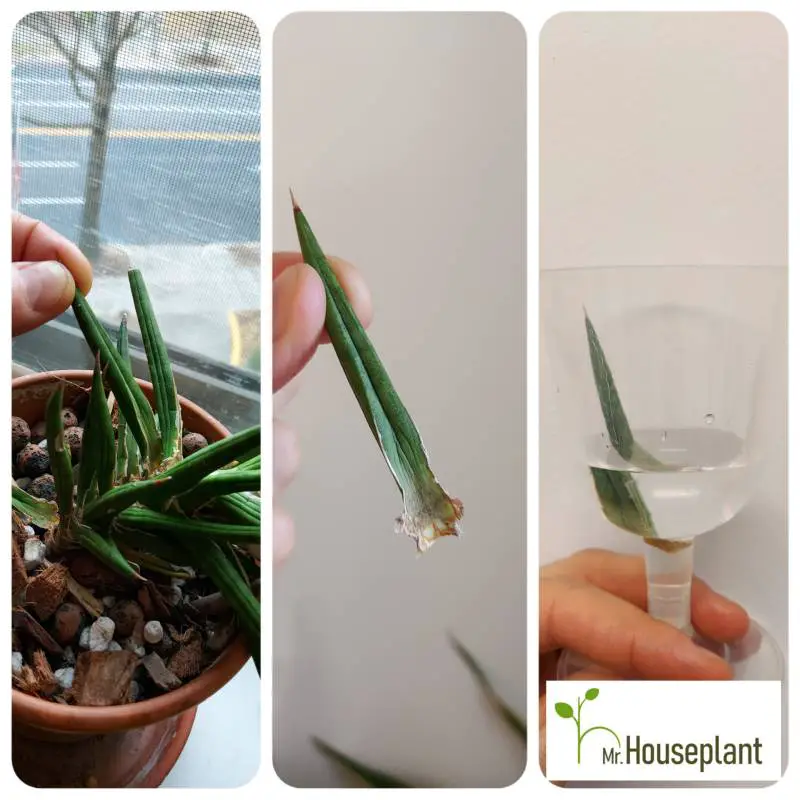
Photo info: Leaf propagation in water
Leaf Cuttings In Soil
To propagate a Sansevieria Francisii through leaf cuttings in soil follow these steps:
- Cut off a whole leaf (or cut off a single leaf into several sections)
- Fill a shallow pot with a well-draining soil mix (1 part soil, 1 part perlite)
- Pot the cut leaf in the pot (Make sure to keep the same leaf orientation. If you turn a leaf upside-down, it won’t be able to absorb moisture and will die)
- Put the pot in a warm spot with bright light (over 10,000 lux)
- Water once the soil is 100% dry
- If the soil stays wet longer than a few days, increase light and repot to a terracotta pot
- In a few months to 1 year, a new leaf will grow
Division
If your Francisii Sansevieria Snake Plant has more than 1 plant in the pot, you can propagate it through division. Division is separating the two plants at the root level and potting them individually. By doing this, you will get two separate plants. To propagate this plant through division, follow these steps:
- Take the plant out of the pot
- Remove just enough soil to expose the rhizome connecting the 2 plants
- Take a sterilized knife
- Cut the rhizome in the middle, between the 2 plants. You can also break it off with your hands
- Leave both plants for a day or two so the cut rhizomes dry out
- Pot the plants in individual pots
Rhizome Cuttings
To propagate a Francisii Sansevieria you don’t have to cut off your plant’s beautiful leaves. You can use a piece of the rhizome to create a new plant. To propagate this plant through rhizome cuttings, follow these steps:
- Take the plant out of the pot
- Remove soil to expose the rhizome (thick fleshy roots)
- Take a sterilized knife
- Cut off a part of the rhizome (the bigger the better)
- Leave the rhizome for a few days so the wound can heal
- Pot the rhizome in a shallow dish with well-draining soil (1 part soil, 2 parts perlite)
- Keep the pot in a warm place
- Water once every 2-4 weeks (make sure the soil is fully dry before watering and don’t let the soil stay moist longer than a week)
- In several weeks, the rhizome will develop roots
- In several months to 1 year, it will grow a new leaf
The speed of propagation and the leaf size will depend on the size of the original rhizome cutting. A bigger rhizome will have more energy and be able to produce a larger leaf.
But the key in the propagation process is to not keep the rhizome moist for longer than 1 week. You can avoid this by using a heat mat. A heat mat will increase soil temperature by several degrees. It will speed up the drying of the soil. And it will help the rhizome grow roots faster.
Seeds
Even though Francisii Sansevieria can be propagated through seeds, it takes a long time for the plant to flower. It also takes a long time to grow a plant from seeds. Leaf cuttings, division, and root cuttings are much faster and easier ways to propagate it.
How Long Does It Take To Propagate Sansevieria Francisii?
Francisii Sansevieria is a slow grower. It takes several months to 1 year to propagate it.
Pests
The most common pests that affect Sansevieria Francisii are scales and thrips. Even though spider mites can affect other Spider plant species, Sansevieria Francisii is not one of them. If you have some experience with spider mites attacking this plant, you can share it in the comment section.
Scale Pests
Dracaena Francisii Chahin is generally pest free, but it can occasionally get infested with scale. The best way to get rid of scale is to scrape off physically as many scales as you can. Then treat the whole plant with insecticidal soap, horticultural oil, or neem oil.
These products work better against soft scales than armored scales. Armored scales are protected by their armor, so the products might not penetrate it. Your best bet is to apply them when scales are young. Another way to get rid of scales is to use a systemic insecticide.
Thrips Pests
Thrips are particularly difficult pests to get rid of. The best way to get rid of thrips is to use a systemic insecticide. Add 1 teaspoon of systemic insecticide per gallon of water and water the plant. The plant will absorb insecticide through the water. As thrips feed on the plant, they will ingest the insecticide and die.
Diseases
The most common diseases that affect these plants are fungal Red Leaf Spot and Southern Blight as well as bacterial Soft Rot (Erwinia carotovora). Red leaf spot (Fusarium leaf spot) is characterized by reddish-brown lessions, oftentimes with a yellow border, that usually occur on young leaves. The lesions occur when the leaves are wet and fungal spores are present. If your plant is infected, treat it with a fungicide and keep the foliage dry.
Southern Blight (Sclerotium rolfsii) is characterized by water-soaked necrotic lessions on leaves near the soil. The lesions lead to stem rot and wilting. Diseased plants should be discarded.
Bacterial soft rot is relatively frequent during propagation. It is characterized by mushy soft rot of the lower end of leaves, sometimes with a fishy, rotten odor. To prevent soft rot infections, make sure the plant leaves stay dry.
Common Problems
Shriveled Leaves
Shriveled leaves are caused by underwatering. Water the plant, and make sure the soil is fully saturated. After a day or two, the leaves should return to normal.
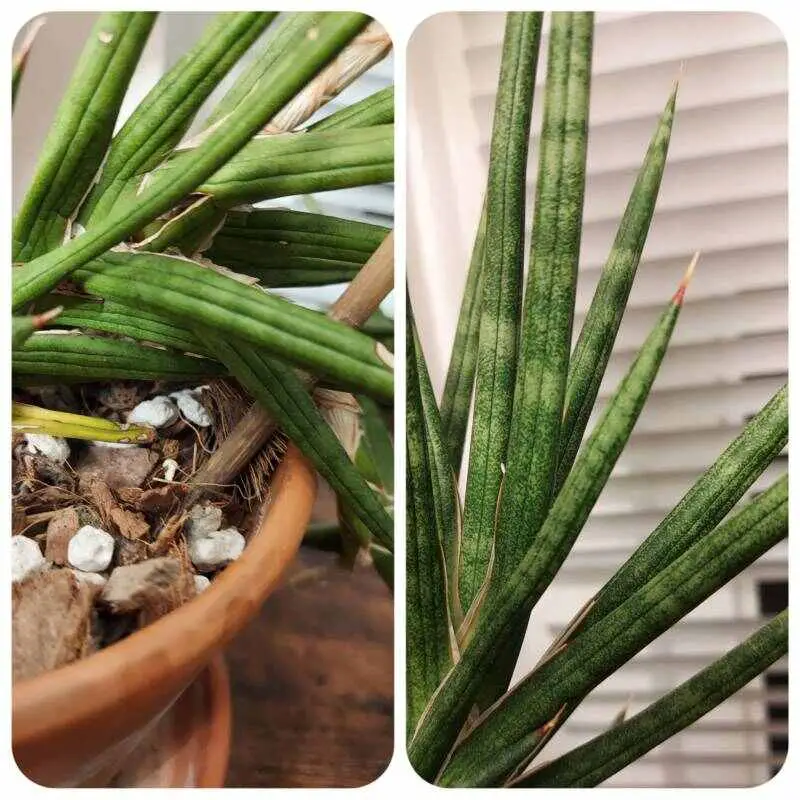
Shriveled, underwatered leaves vs. normal leaves
Soft and mushy leaves
Soft and mushy leaves are usually a sign of root rot caused by overwatering. If your plant has soft and mushy leaves, take it out of the pot. Remove all soil and cut off all soft and mushy roots. Repot in a fresh well-drained potting mix. And place the plant in the brightest spot in your home.
Tips To Grow Dracaena Francisii Problem Free
Here are the best tips to grow Dracaena Francisii without problems. If you stick to these Sansevieria Francisii care tips, you are unlikely to experience any problems:
- Keep the plant in bright light, over 750 lux (75 foot candles). Ideal lighting conditions would be light over 10,000 lux with a few hours of early morning direct sun.
- Pot in a well-draining mix that’s not compacted and has a lot of oxygen for the root system.
- Water once the soil is 100% dry
FAQ
How Do You Take Care Of Sansevieria Francisii?
To take care of Sansevieria Francisii you need to provide medium indirect light (over 750 lux) and water it when the soil is completely dry. Also, make sure that the plant is growing under its optimal temperature (18C° to 24C°).
How Big Does Sansevieria Francisii Get?
Sansevieria Francisii is a plant whose stem can get 10-30 cm (4-12 inches) long and leaves can get up to 8-15 cm (3-6 inches) long.
What Is The Common Name For Sansevieria Francisii?
The common name for Sansevieria Francisii is Snake Plant and its proper botanical name is Dracaena Francisii. It used to belong to the Sansevieria genus, but is now classified under the Dracaena genus.
Final Thoughts
Sansevieria Francisii is an easy-to-care plant, if you follow all the care requirements. It’s a drought-tolerant plant. Provide it with medium light. Water it once the soil is fully dry. Fertilize it during its growing season to avoid the accumulation of nutrients in the soil. Provide it with the optimal temperature (the plant doesn’t tolerate freezing temperatures).
Yours Truly,






I have a runner in my Sansevieria francisii and it got very big and is tipping the mother plant over. So I broke it off. Now I don’t know how to plant the runner! It’s a very long ✔️ shape. With the spiky leaves on the shorter arm
Hi Lin, plant the runner so that the long stem lays horizontally on the soil and the leaves are facing up. Cover the bottom of stem with soil, so that the stem can absorb moisture from it. You can also cover not just the bottom of the stem, but the whole horizontal part of the stem. Let me know if it’s unclear or you have any additional questions 🙂
Same here with a long runner broken off, you said to lay it ON the soil, not IN the soil, right? What happens to the mother plant, will it slowly decrease once it has started growing runners? I don’t want it to die, how do I support it in growing new runners?
Hi Yana, I’m sorry I wasn’t very clear in my previous reply. In that particular case, the the runner was bent so I suggested to lay the stem on the soil so that one part is horizontal on the soil and the top of the stem faces up. Of course, the bottom of the stem should be covered with soil.
If your runner is straight, you can stick it IN soil. The bottom of the stem should be in the soil, so it can absorb moisture.
Your mother plant will be fine. Make sure to pot it in a well draining succulent or cacti mix, to provide it with sufficient light and to not water until the soil has fully dried out. And your plant will thrive 🙂